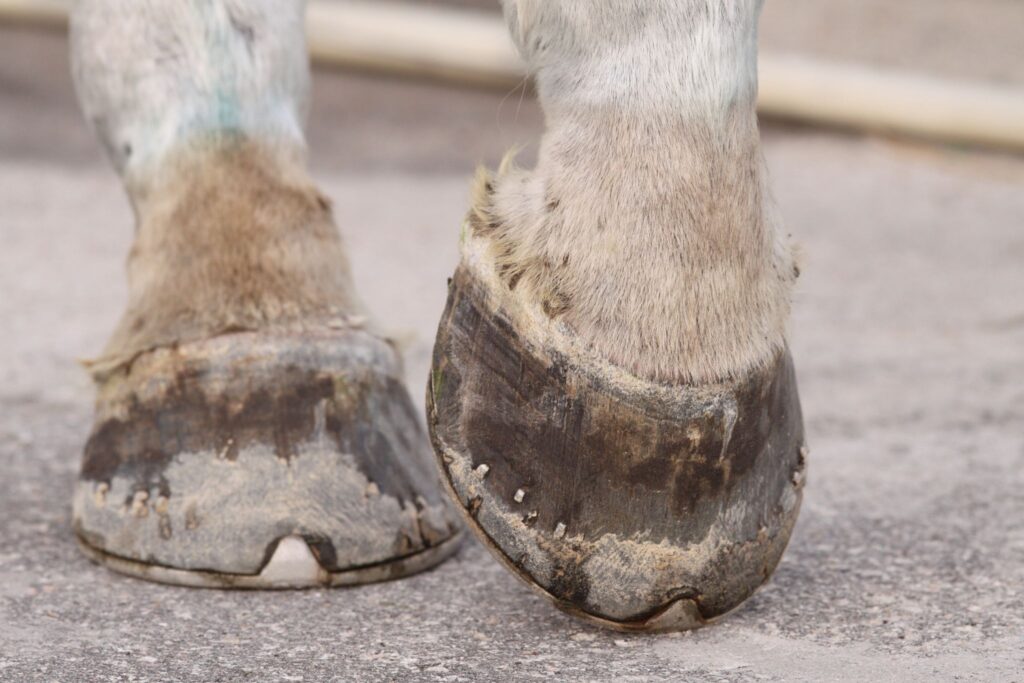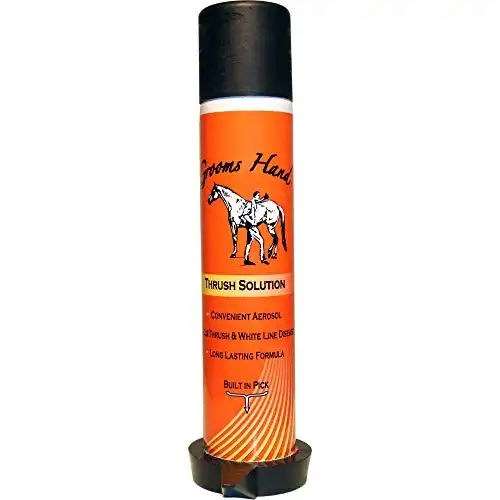Horse News
Member
Addressing Common Equine Hoof Ailments
While you should never look a gift horse in the mouth, you might want to check out its hooves before you take it home. I was fortunate enough to be given a horse (well, a fat pony) earlier this year. He’s in good health overall, although he would benefit from losing a few pounds! Sadly, his feet have been neglected, forcing me to brush up on my hoof-trimming skills and learn a thing or two about common horse hoof conditions.
You can easily avoid the most common hoof ailments with regular hoof maintenance, management, and good nutrition. Without those essentials, your horse’s hooves are liable to get cracked, crumbly, and become susceptible to issues like white line disease and thrush.
While these issues are relatively easy and inexpensive to treat, if left unattended, they can become severe, causing pain, lameness, and other chronic problems.

Source: Canva
What Is Seedy Toe?
My pony hadn’t had his hooves trimmed regularly for several years and had persistent cracks at the front of all four feet. Initially, I treated this by simply trimming the toes as short as I could without compromising the shape of the hoof.
While this approach appeared to have a positive impact, within a couple of weeks the cracks would reappear. At that point, I realized something more serious was going on, and after doing a bit of research, came up with seedy toe as a potential cause.
Seedy toe, also called white line disease, is a fungal infection that affects the white line of the hoof—the soft part that joins the sole to the wall.
It often occurs at the toe, especially if the hooves have been allowed to grow too long, as that puts increased strain on the white line, compromising its integrity. Even a small crack in the wall of a horse’s hoof could indicate an extensive underlying infection and requires further investigation.
How to Treat Seedy Toe in Horses
You have to dig deep to get to the bottom of a seedy toe infection. When trimming the hoof, you’ll see a dark area within the white line. If you start digging into this area with a knife, you’ll likely find more dirt and blackened tissue, indicating a deeper infection.
Note: If you’re new to hoof care, consult your farrier and/or vet for help.
As the infection is fungal, it thrives in darkness, so you want to open up the site of the infection as much as possible. Air and light will help fight the disease, so the more you can expose, the better. You will want to seek the help of a professional to do this if you’re not comfortable or confident trimming your own horse’s hooves. Your vet or farrier are great resources!
Once you or your farrier has dug out as much of the infected tissue and crumbly hoof wall as possible, apply an antifungal or antimicrobial product to the area.
I’m currently soaking my horse’s feet in diluted apple cider vinegar daily and applying it as a topical spray between the soakings.
Apple cider vinegar has potent anti-fungal properties, making it an effective treatment for seedy toe, greasy heel, thrush, and other hoof-based infections. Other natural treatments include hydrogen peroxide, iodine, and tea tree oil.
Diagnosing and Treating Other Common Hoof Ailments
Thrush
Thrush is one of the most common hoof ailments in horses and one that many owners will be familiar with. It’s a bacterial infection that affects the frog, causing it to break down.
Warning: It also emits a foul-smelling black discharge in the process!
To treat thrush, you need to clean away the affected tissue and discharge and then apply a topical treatment. Diluted apple cider vinegar is very effective, but you can also use dedicated thrush treatments like Grooms Hand Thrush Solution.
Grooms Hand Thrush Solution
$21.99

Click to see it at Amazon
01/23/2024 07:50 am GMT
For more tips on preventing and treating thrush, check out our posts about Thrush in Horses 101: Prevention and Treatment and Fungus Free: Easy Homemade Remedies for Horse Thrush.
Greasy Heel/Mud Fever
A friend of mine battles with mud fever, or pastern dermatitis, all year round because her horses must wade through a swamp to get from their paddock to their stables. This constant soaking causes sores to develop on her horses’ pasterns and lower legs. As these worsen, they cause inflammation and, in extreme cases, become infected, causing proud flesh to form.
Coat Defense Drying Paste
$46.80

Click to see it at Amazon
01/23/2024 07:50 am GMT
Caused by both bacteria and fungus, mud fever flourishes in wet conditions, so keeping your horse’s feet and legs dry will go a long way to prevent this particular problem.
The best way to treat mud fever is to trim or clip away the feathers around the affected area to help keep it clean and dry. Then, wash the area with an antibacterial wash or shampoo, removing as many scabs as possible. Once clean and dry, apply either diluted apple cider vinegar or another topical treatment.
Recovery can take several weeks, during which you may want to wrap or bandage the legs to prevent further infection.
Only do this if you can keep your horse in dry conditions, as wet bandages will exacerbate the problem.
White Line Disease
White line disease is the same as seedy toe, but the term is more commonly used when the infection is in either the sides or back of the hoof.
Laminitis and Founder
Laminitis is painful and debilitating. In severe cases, it causes founder—a condition in which the coffin bone separates from the laminae that connect it to the hoof wall.
Unlike mud fever or seedy toe, laminitis is an inflammatory condition rather than an infection, and may require a more holistic treatment. You can find out more about treating laminitis and founder in our article on Foundering in Horses: Figure Out Your Fix.
Often associated with obesity, it’s a lot easier to prevent laminitis than it is to treat it.
Restricting your horse’s access to lush pasture (especially during certain times of day and seasons), reducing his sugar intake, and following a rigorous hoof management regime are great ways of reducing the risk of laminitis.
Navicular
Navicular disease or syndrome affects a small bone at the back of the horse’s hoof. It usually occurs in the front feet, causing inflammation and degeneration of the navicular bone, often leading to chronic lameness.
Ponies and donkeys appear to have a natural resilience to the condition, which most commonly affects athletic horses who experience repetitive stress on their front limbs.
Although there is no cure for navicular disease, with the proper treatment and support, many horses with the condition enjoy long periods of soundness and may even return to competition.
This article provides deeper insights into diagnosing and managing navicular syndrome.
How to Prevent Common Hoof Problems
While you might not be able to move your horse to an arid area or stop him from feasting on fresh grass every spring, you can take some preventive action to reduce the risk of common hoof ailments and infections.
Proper Nutrition for Hoof Health
Diet is critical for maintaining healthy hooves, and you can prevent many conditions simply by reducing the amount of starch and sugar your horse is ingesting and ensuring he has access to plenty of fresh water.
You could also consider adding trace minerals and vitamins like zinc and biotin to your horse’s feed to boost hoof health.
Regular Hoof Maintenance
Cleaning out your horse’s hooves daily will help prevent infections. You can also apply apple cider vinegar to the frog to help prevent fungal infections.
Make sure you remove all dirt and debris from the grooves or clefts on either side of the frog using both a hoof pick and brush.
Regardless of whether or not your horse wears shoes, his hooves need regular trimming to prevent cracks and maintain proper balance. Most horses need their feet trimmed every six weeks, but it does vary according to the horse, the type of work he’s doing, and the environment he lives and works in.

Source: Canva
Environmental Considerations
A horse that’s constantly exposed to mud, manure, or moisture will be more susceptible to hoof problems than one living in an arid desert. Exposure to damp conditions causes the hooves to soften, making them more prone to infections like thrush and white line disease.
You can improve your horse’s hoof health by mucking out his stall daily to keep it clean and dry.
If your horses live out 24/7, like mine, this can be more challenging. Keeping your paddock clean by routinely removing manure can help, as can putting pea gravel down in areas where your horses commonly eat or rest.
Frequently Asked Questions
Q: Can I ride a horse with seedy toe?
It’s generally better to rest a horse with a hoof infection, especially if weak or crumbling hoof walls contributed to the condition.
Q: Is greasy heel painful?
In its early stages, greasy heel is generally painless, but as the lesions and inflammation develop, the condition can become painful, causing itching and lameness.
Q: Can a horse recover from founder?
Many horses do recover from founder, although the process can often take weeks, if not months.
Parting Thoughts
Regular hoof care, proper nutrition, and environmental management all help to prevent common hoof problems like thrush, mud fever, and white line disease. Regular exercise can also help, especially with conditions like founder or laminitis, that are often associated with equine obesity.
Obviously, you can inherit problems, as I did with my fat pony, at which point you need to treat the condition promptly to prevent it from worsening and causing lameness.
P.S. Enjoy this article? Trot on over to:
- Horse Hoof Terminology
- Get a Leg Up on Equine Limb Terminology
- Horse care 101: Turnout blankets vs. stable blankets
- Horse Riding Equipment List: What You Need & What You Don’t
- Beginner’s Guide to Horse Hay Nets & Bags
- The Ultimate Packing & Horse Trailering Checklist
The post Hoof Talk: Tackling Seedy Toe, Thrush, Mud Fever & More appeared first on Horse Rookie.
Continue reading...
